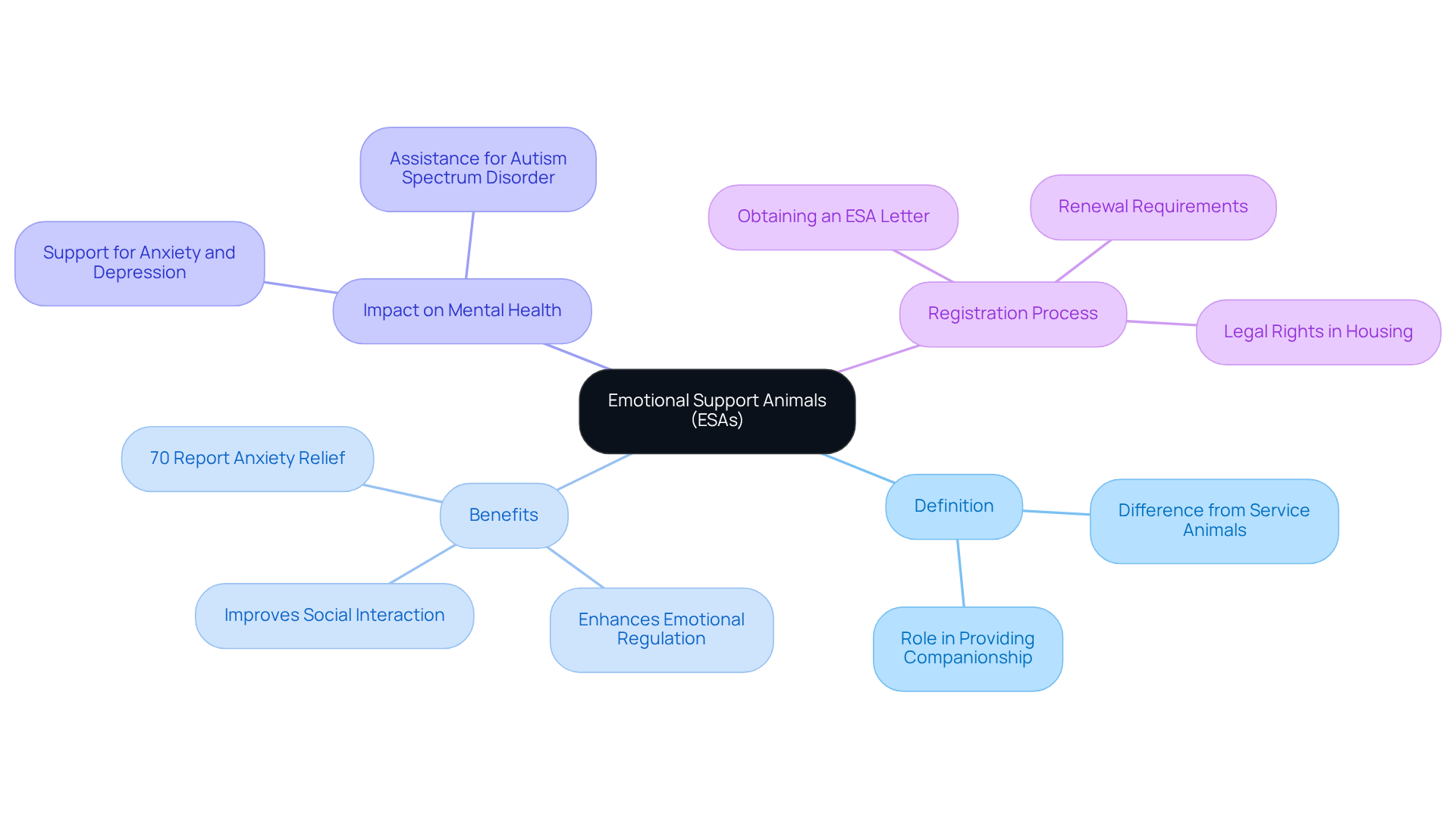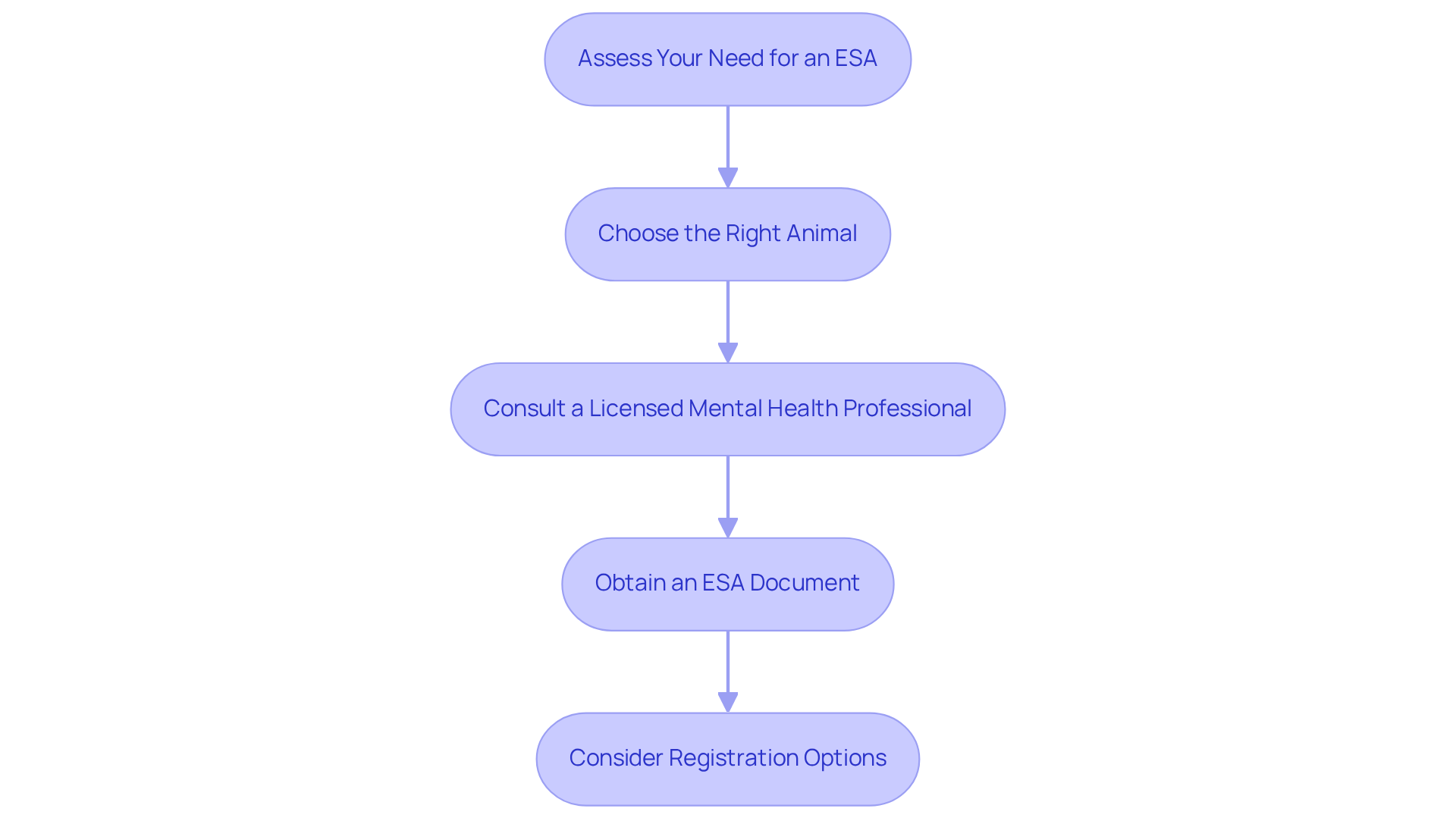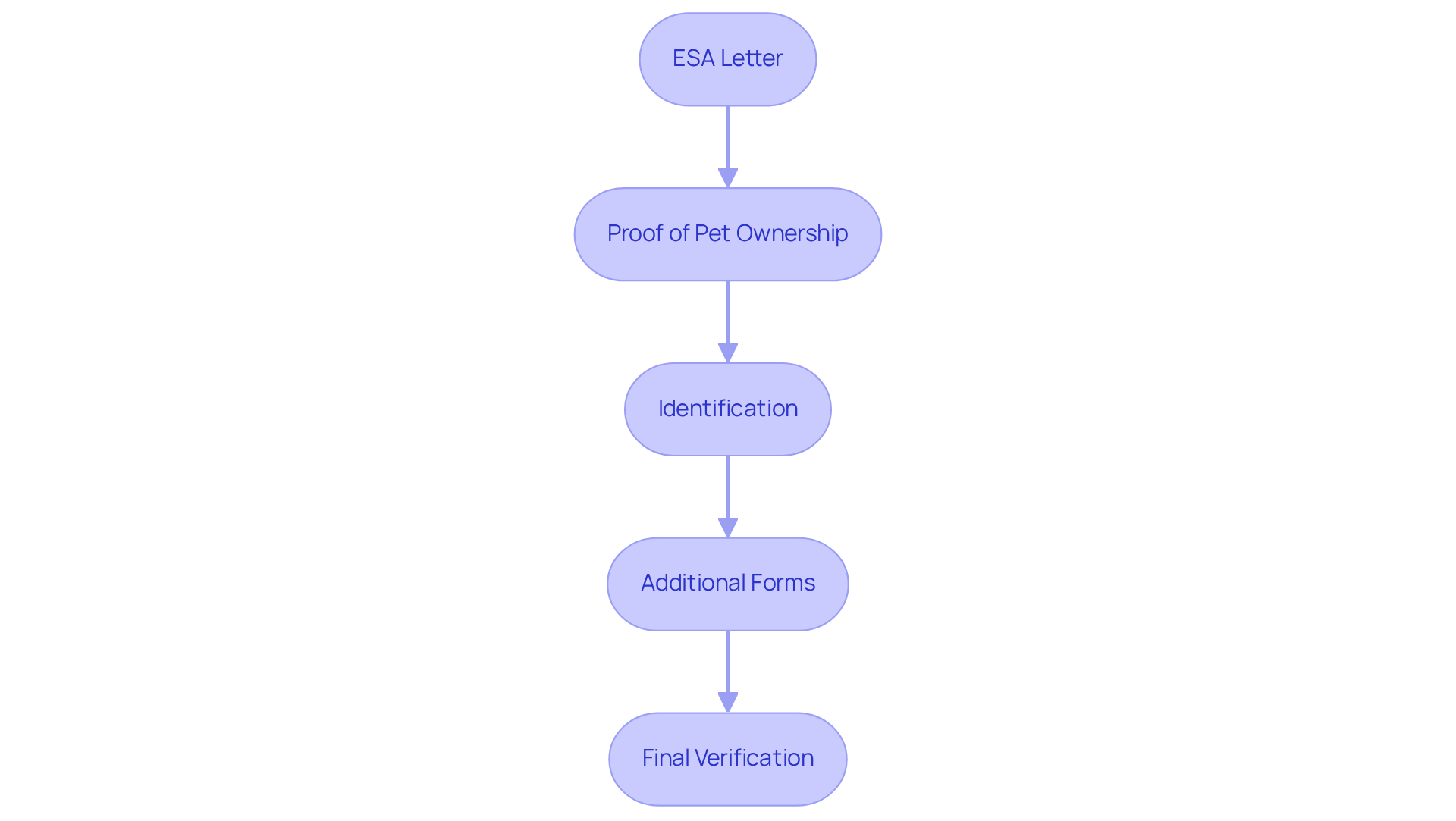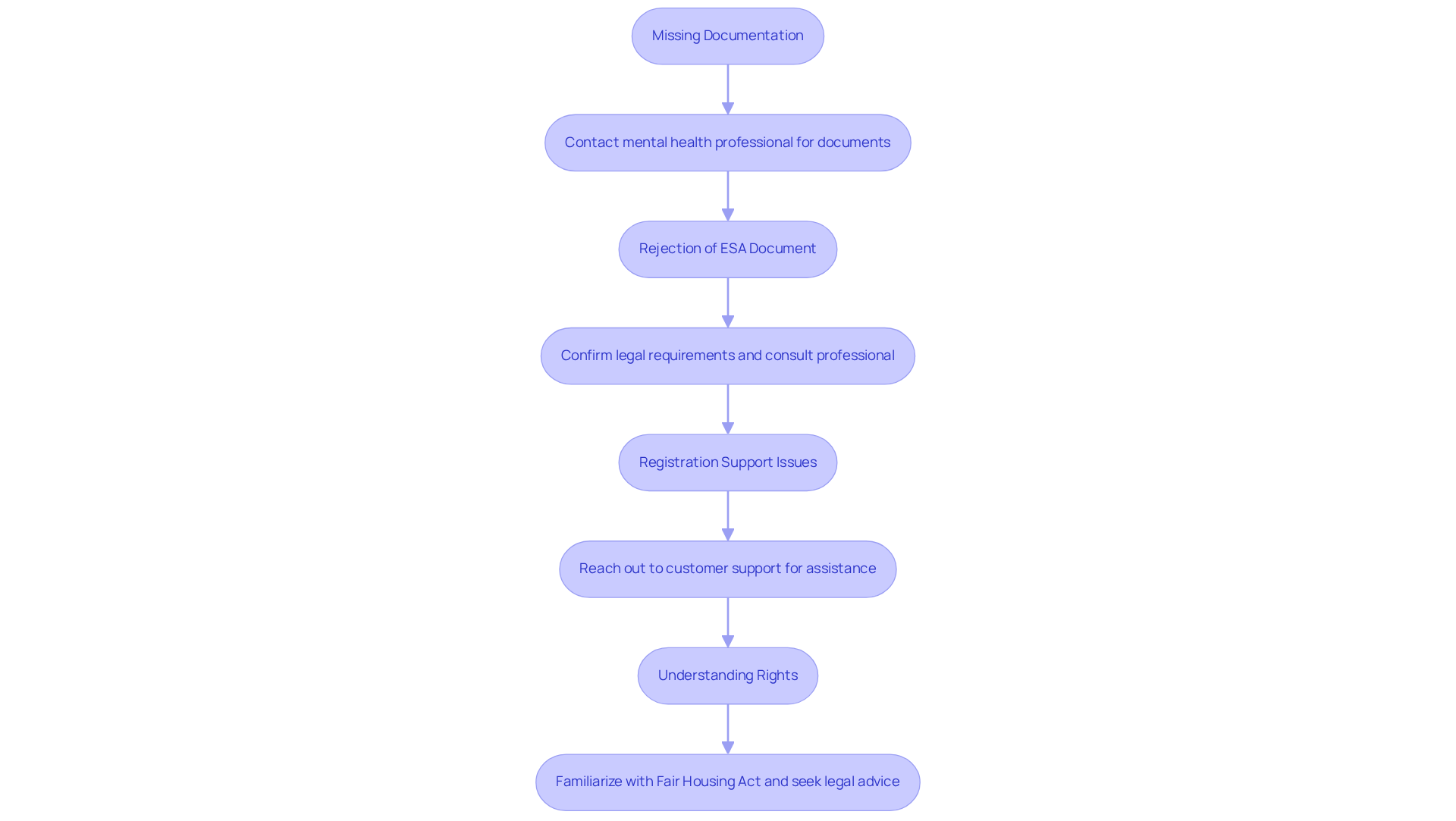

How to Register Animal as Emotional Support: A Step-by-Step Guide
by Lena Park
Last updated: August 24, 2025
Verified and Approved by:
Angela Morris,
MSW, LCSW
Fact Checked

Overview
This article offers a heartfelt step-by-step guide on registering an animal as an Emotional Support Animal (ESA). It recognizes the emotional challenges that individuals with mental health issues often face and emphasizes the significance of obtaining a legitimate ESA document from a licensed mental health professional. This crucial process not only allows individuals to legally live with their ESAs but also ensures they can access housing without discrimination. By outlining detailed steps and necessary documentation, the article serves as a compassionate resource, reassuring readers that support is available for their journey.
Introduction
Emotional Support Animals (ESAs) have become essential companions for those facing emotional or psychological challenges, providing comfort and stability during difficult times. As our understanding of mental health continues to grow, the importance of registering an animal as an ESA becomes increasingly clear for individuals seeking to benefit from the therapeutic support these loving pets offer. Yet, the registration process can often feel daunting, leaving many to ask: what are the crucial steps and documentation needed to ensure their beloved companions can legally accompany them in housing and travel?
Navigating these challenges can be overwhelming, but remember, you are not alone in this journey. The emotional toll of mental health issues can weigh heavily, and the presence of an ESA can offer a much-needed sense of relief. These animals not only provide companionship but also help foster an environment of peace and security.
As you consider the path to registering your ESA, know that there is support available to guide you through the necessary steps. An ESA letter can serve as a vital tool, affirming the therapeutic role your pet plays in your life and helping to ease the burdens of housing and travel restrictions.
Take a moment to reflect on your own experiences and the comfort your furry friend brings. The journey to securing an ESA is not just about paperwork; it’s about recognizing the profound bond that can help you navigate life’s challenges with greater ease. Together, you and your ESA can create a nurturing environment that fosters healing and growth.
Define Emotional Support Animals and Their Purpose
Emotional Support Animals (ESAs) are cherished companions that offer vital comfort and support to individuals navigating emotional or psychological challenges. Unlike service animals, which are trained to perform specific tasks for people with disabilities, ESAs primarily provide companionship and emotional stability. They play a crucial role in alleviating symptoms associated with anxiety, depression, and PTSD. Research indicates that a significant percentage of individuals utilizing ESAs experience improvements in their mental health; for example, nearly 70% of ESA users report anxiety relief as a primary benefit.
At Wellness Wag, we deeply understand the transformative power of these incredible companions. The bond between an ESA and its owner is essential for fostering mental well-being. These animals can sense their owners’ emotional states, often providing solace during difficult moments. Experts emphasize that the presence of an ESA can greatly enhance emotional regulation and social interaction, particularly for individuals coping with conditions like Autism Spectrum Disorder (ASD).
Understanding the purpose of ESAs is vital for those seeking how to register an animal as emotional support, as it underscores the importance of this unique bond in promoting mental well-being. With an ESA document from Wellness Wag, individuals can legally live with their emotional support pets in housing situations without facing discrimination. The process of obtaining an ESA document includes a consultation with our team, ensuring that individuals receive the necessary guidance and support. It is important to note that an ESA letter is valid for one year and must be renewed annually to maintain these rights, allowing individuals to continue reaping the emotional benefits that these companions provide.

Follow the Step-by-Step Registration Process
-
Assess Your Need for an ESA: Start by gently reflecting on your emotional or psychological needs. Think about how a beloved creature could enhance your well-being. Consulting with a licensed mental health professional can offer valuable insights into whether an ESA may be the right fit for you.
-
Choose the Right Animal: It’s important to select a pet that resonates with you emotionally. The bond you share with your pet is vital for the support you seek. While dogs and cats are common choices, remember that other animals can also serve as effective ESAs, bringing joy and comfort into your life.
-
Consult a Licensed Mental Health Professional: Take the step to schedule an appointment with a qualified therapist or psychiatrist. They will compassionately evaluate your mental health needs and help determine if an ESA is appropriate for your unique situation. This step is crucial, as a licensed expert must diagnose you with a qualifying condition to issue an ESA document.
-
Obtain an ESA Document: If your mental health professional approves your request, kindly ask for an official ESA document. This document should clearly state your need for an ESA and include the professional’s contact information. Typically, you can expect to receive this letter within 24 to 48 hours, ensuring you have timely support when you need it most.
To understand the process, one must learn how to register an animal as emotional support. While registration is not legally required, certain platforms provide options on how to register an animal as emotional support, which can offer additional documentation. Utilizing a reputable service like Wellness Wag can help streamline this process, ensuring you have the necessary paperwork to advocate for your rights under the Fair Housing Act.

Gather Required Documentation and Verify Eligibility
Successfully learning how to register an animal as emotional support can feel daunting, but gathering the right documentation can make the process smoother and more reassuring. Here’s what you need:
-
ESA Letter: This vital document must be issued by a licensed mental health professional. It should clearly state your name, the professional’s credentials, and a declaration of your need for an ESA. Many individuals face challenges with ESA letters that don’t meet legal requirements, highlighting the importance of obtaining a legitimate letter from a qualified provider to ensure your emotional needs are recognized.
-
Proof of Pet Ownership: Compile documentation that verifies your ownership of the animal, such as adoption papers or veterinary records. This helps establish your bond with your pet, which is crucial for understanding how to register an animal as emotional support and affirms the support your animal provides.
-
Identification: Keep a copy of your ID easily accessible, as some registration options may require it for verification. This simple step can help ensure that your application is processed without delay, allowing you to focus on what truly matters—your emotional well-being.
-
Additional Forms: If you are using a registration system, check whether they require any specific forms or additional information to finalize the process. Each offering may have unique requirements, so it’s essential to verify these details in advance to avoid any unnecessary stress.
Licensed experts emphasize that understanding how to register an animal as emotional support and possessing a valid ESA document is crucial for safeguarding your rights under the Fair Housing Act and other regulations. Proper documentation not only facilitates access to housing and travel accommodations but also protects you from potential disputes with landlords or service providers. Many individuals have shared how thorough documentation has made a significant difference in their journey, reinforcing the need for careful preparation and support. Remember, you are not alone in this process, and there are resources available to help you every step of the way.

Troubleshoot Common Registration Issues
-
Missing Documentation: If you find that essential documents are missing, please reach out to your mental health professional as soon as possible to obtain a new ESA certificate or any other necessary paperwork. It’s so important to ensure that all documentation is complete and meets the required guidelines, as incomplete submissions can lead to frustrating delays or rejections.
-
Rejection of ESA Document: If your ESA document is denied by a housing provider or airline, take a moment to confirm that it meets all legal requirements. Common reasons for denial often include missing appropriate documentation, such as a letter that isn’t on official letterhead or isn’t signed and dated within the last two years. Consulting your mental health professional can provide clarity or help you secure a revised letter that addresses any shortcomings.
-
Registration Support Issues: If you experience difficulties with a registration system, don’t hesitate to reach out to their customer support for assistance. Having all your documentation organized and ready can significantly speed up the resolution process. If the service is unresponsive, it might be worth exploring alternative registration options that could offer better support.
-
Understanding Rights: It’s crucial to familiarize yourself with your rights under the Fair Housing Act and the Air Carrier Access Act, which protect your ability to have an ESA in housing and during travel. If you face discrimination, seeking legal advice may be beneficial to understand your options and ensure your rights are upheld. Being aware of these laws can empower you to advocate effectively for your ESA.

Conclusion
Emotional Support Animals (ESAs) are more than just pets; they are vital companions that offer comfort and stability to those grappling with emotional or psychological challenges. It’s essential to understand how to register an animal as an ESA for anyone seeking the profound benefits these unique relationships can provide. By following the outlined steps, individuals can secure the necessary documentation to advocate for their rights and nurture the crucial bond with their animal.
This article offers a compassionate, step-by-step guide, beginning with:
- Assessing the need for an ESA
- Selecting the right pet
- Consulting a licensed mental health professional
- Obtaining an official ESA document
The importance of proper documentation, including an ESA letter and proof of pet ownership, cannot be overstated, as it safeguards your rights under relevant laws. Additionally, we address common registration issues to prepare you for any potential challenges you may face.
Ultimately, the journey of registering an emotional support animal transcends mere paperwork; it is about fostering a supportive relationship that can significantly enhance your emotional well-being. By recognizing the transformative power of ESAs and understanding the registration process, you can take meaningful steps toward improving your mental health. Embracing this journey can lead to a more fulfilling life, highlighting the essential role of companionship in overcoming emotional hurdles. Remember, you are not alone on this path; support is available to help you every step of the way.
Frequently Asked Questions
What are Emotional Support Animals (ESAs)?
Emotional Support Animals (ESAs) are companions that provide comfort and support to individuals experiencing emotional or psychological challenges. They primarily offer companionship and emotional stability rather than performing specific tasks like service animals.
What is the purpose of having an ESA?
The purpose of an ESA is to alleviate symptoms associated with mental health issues such as anxiety, depression, and PTSD. They help enhance emotional regulation and social interaction, particularly for individuals with conditions like Autism Spectrum Disorder (ASD).
How effective are ESAs in improving mental health?
Research shows that a significant percentage of individuals using ESAs experience mental health improvements, with nearly 70% reporting anxiety relief as a primary benefit.
How do ESAs contribute to emotional well-being?
ESAs can sense their owners’ emotional states and provide solace during difficult moments, fostering a strong bond that is essential for mental well-being.
How can someone register an animal as an emotional support animal?
To register an animal as an ESA, individuals need to obtain an ESA document through a consultation with Wellness Wag, which provides guidance and support in the process.
What are the legal benefits of having an ESA document?
An ESA document allows individuals to legally live with their emotional support pets in housing situations without facing discrimination.
How long is an ESA letter valid, and what is required for renewal?
An ESA letter is valid for one year and must be renewed annually to maintain the rights associated with having an emotional support animal.
Certify Your Emotional Support Animal Today

Why You Can Rely on Us?
At Wellness Wag, we believe your pet deserves care rooted in both science and compassion. Each article is carefully researched, written in clear language for pet owners, and then reviewed by qualified professionals to ensure the information is evidence-based, current, and practical for real-life care. Our goal is to help you feel confident in making informed decisions about your pet’s health and well-being.
Reviewed by
Angela Morris, MSW, LCSW
Angela is a licensed clinical social worker with 20 years of experience in patient advocacy and community mental health. She has assisted numerous clients with ESA evaluations and brings a deep understanding of disability accommodations, ensuring that all information is accurate, supportive, and practical.

Written by :
Lena Park
Last Updated :
August 24, 2025












